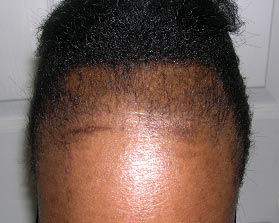Calvicie y Alopecia

¿Existe una cura?
You probably heard of hair loss or suffered from it at some point in your life specially if you’re of so called black descent. Hair loss is scientifically called alopecia and there are many types, causes, some are curable some not. Continue reading to understand more how to tackle the problem by the roots…
What is it really?
According to the Belgravia Centre (a London clinic expert in treating this ailment) alopecia is the Latin word for hair loss, and the term encompasses a range of conditions. There are many types of alopecia, depending in how the hair loss manifests, location of loss, gender of the victim, etc. The most common types highlighted by the centre are: Traction Alopecia, Androgenic Alopecia, Alopecia Areata, Alopecia Totalis, Alopecia Universalis and Cicatricial Alopecia.
What causes it?
It is thought that the main cause of alopecia is an autoimmune reaction. This means the body’s immune system incorrectly attacks the body’s own cells. In the case of alopecia, the cells under attack are the hair follicles.
It can also be genetic (inherited), particularly when the disorder strikes those under age 30. Almost 40% of people younger than age 30 with alopecia have at least one family member who has been diagnosed with the same disorder.
Hormones can also play a role specially for pregnant women. There are many reports of women that lose huge patches of hair a few weeks or months after giving birth due to the drastic hormonal changes. Men are the most common sufferers of hair loss due to hormonal changes as they age they tend to lose hair too.
The risk of developing alopecia is unusually high in people who have asthma, hay fever, thyroid disease, vitiligo (a condition in which patches of skin lose their color), pernicious anemia and Down syndrome.
Although experts once believed episodes of alopecia areata could be triggered by stress, newer research has failed to prove that stress is a factor.
Types of Alopecia
Traction Alopecia
Traction Alopecia differs from other types of Alopecia in that it is usually caused directly by the actions of the individual which result in excessive tension on the hair and breakage. This is the most common type among black women. Certain hair styles, such as braiding and tight ponytails are common causes of Traction Alopecia. It can also be caused by repeated treatments with chemicals, such as hair colouring and bleaching.
Androgenic Alopecia
Androgenic Alopecia is the scientific name for the genetic hair loss conditions Male Pattern Baldness and Female Pattern Hair Loss. It is the most common form of hair loss, and affects many individuals at some point in their lives, sometimes as early as the late teens or early twenties.
The condition is caused when enzymes in the body begin turning the hormone testosterone into its derivative, dihydrotestosterone, which has the effect of shrinking the hair follicles. A tendency for Androgenetic Alopecia can be passed down through the genes on either the paternal or maternal side.
Male Alopecia
Alopecia Areata
This is the type of hair loss most commonly associated with the term ‘Alopecia’ in media reports. Alopecia Areata usually presents itself as patchy hair loss on the scalp, and is an autoimmune disorder which causes the body’s own immune system to attack healthy hair follicles. The exact causes of the condition remain unknown, but it is widely thought to be triggered by stress and traumatic events. Read more about this type of alopecia here: https://www.drugs.com/health-guide/alopecia-areata.html
Alopecia Totalis and Alopecia Universalis
In some cases, Alopecia Areata can progress to the entire scalp. This is known as Alopecia Totalis. At its most extreme the hair loss can occur across the entire body, including eyebrows. Little Britain co-creator Matt Lucas suffers from this type of hair loss, which is known as Alopecia Universalis.
Cicatricial Alopecia
Also known as Scarring Alopecia, the condition Cicatricial Alopecia is a type of hair loss in which hair follicles are destroyed and replaced by scar tissue. There are two types of Cicatricial Alopecia- primary and secondary. In the case of Primary Cicatricial Alopecia, the hair loss is caused directly by inflammation of the hair follicles, the causes of which are little understood. Secondary Cicatricial Alopecia, meanwhile, refers to scarring hair loss which occurs as a result of an event or process unrelated to the follicles, such as burns or infections.
How to avoid it?
The only type of alopecia that can be avoided is traction alopecia as it is self inflicted. All other types are not avoidable as the causes are out of the individuals control per se.
How to treat it?
Natural treatments
Castor oil, fenugreek seeds, rosemary and peppermint essential oil diluted in a light carrier oil, rice water rinse, and the list goes on and on. There are many natural hair growth boosters and stimulants which aid in the regrowth of lost hair specially in the edges. Make sure you try a new ingredient or a mixture of many ingredients in a oil or ointment in a small patch of the affected area for a few days before applying to the whole affected area to assure there is no allergic reaction. Try our Herb Infused Hair Oil Serum .
Finasteride and minoxidil
Finasteride and minoxidil are the main treatments for male pattern baldness.
Minoxidil can also be used to treat female pattern baldness. Women should not use finasteride.
These treatments:
– don’t work for everyone
– only work for as long as they’re used
– are not available on the NHS
– can be expensive
Wigs
Some wigs are available on the NHS but you may have to pay unless you qualify for financial help.
Synthetic wigs:
last 6 to 9 months
easier to look after than real-hair wigs
can be itchy and hot
cost less than real-hair wigs
Real-hair wigs:
– last 3 to 4 years
– harder to look after than synthetic wigs
– look more natural than synthetic wigs
– cost more than synthetic wigs
Other hair loss treatments:
Treatment Description
Steroid injection injections given into bald patches
Steroid creams cream applied to bald patches
Immunotherapy chemical applied to bald patches
Light treatment shining ultraviolet light on bald patches
Hair transplant hair cells are moved to thinning patches
Scalp reduction surgery sections of scalp with hair are stretched and stitched together
Artificial hair transplant surgery to implant artificial hairs
References:
1. https://www.belgraviacentre.com/blog/what-are-the-different-types-of-alopecia/
2. https://www.drugs.com/health-guide/alopecia-areata.html
3. https://www.nhs.uk/conditions/hair-loss/
